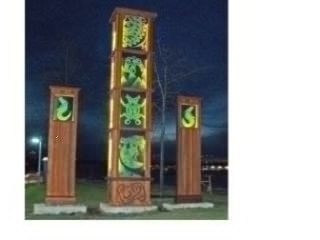Hupakwanum, Nuu-chah-nulth art piece.
Whenever someone walks into the Olympic Speedskating Oval in Richmond to watch speedskating events during the Winter Olympics next week, they’ll be passing by a piece of Port Alberni.
Artists from the Alberni Valley spent months creating a unique piece of aboriginal art that will be a showpiece on the world stage during the 2010 Winter Olympics this month — as well as for years to come.
The piece is called Hupakwanum, which means ‘treasure of the chiefs’. It is made of red cedar and sandblasted glass. Artists Rod Sayers and Tim Paul were the lead carvers, while Tom Paul and Jake Gallic also worked on the piece. Todd Robinson from Cascadia Glass did the sandblasting.
The idea behind the piece is bringing all the wealth of the chiefs of the 13 Nuu-chah-nulth nations to the world stage.
Hupakwanum “is breaking the canon of what contemporary First Nations art is viewed as,” said Kelly Foxcroft-Poirier of White Raven Consulting, which helped organize the project along with the Tseshaht First Nation under the Aboriginal Venues Program.
When First Nations people make a public piece of art, the public expects a totem pole or welcoming figures.
“This is quite a departure from that,” she said.
“It’s a contemporary, glass, lit up piece of artwork. It is based on totemic artwork, but takes it to another level,” she said.
Hupakwanum has also helped put Nuu-chah-nulth artists from the Alberni Valley on the world map.
“Looking at the capacity of our local artists to really pull off something on an international level, that’s what I’d really like people to realize: we can do this.”
Continued / 18
From / 4
The installation took place on Dec. 3, when a delegation of Nuu-chah-nulth people — including the artists — asked permission of the Musqueam people to put their artwork on Musqueam territory. The ceremony is referred to as a “protocol ceremony”.
Before Hupakwanum was boxed up to transport to Richmond, it was put to sleep during a ceremony in Port Alberni. Once it arrived at the speedskating oval and unpacked it was woken up. The protocol was a day-long ceremony involving representatives from the Hesquiaht, Tseshaht and Hupacasath First Nations in the Alberni-Clayoquot region.
Nuu-chah-nulth Tribal Council Chief Cliff Atleo also attended the event.
“The protocol was because it’s not just an art piece,” Foxcroft-Poirier explained. “It’s a living thing that represents the spirits of the artists’ grandparents.”
Once the Olympic Games are over, the City of Richmond will take ownership of Hupakwanum and it will remain as a legacy to the community — and to the Nuu-chah-nulth Peoples.
editor@albernivalleynews.com
Whenever someone walks into the Olympic Speedskating Oval in Richmond to watch speedskating events during the Winter Olympics next week, they’ll be passing by a piece of Port Alberni.
Artists from the Alberni Valley spent months creating a unique piece of aboriginal art that will be a showpiece on the world stage during the 2010 Winter Olympics this month — as well as for years to come.
The piece is called Hupakwanum, which means ‘treasure of the chiefs’. It is made of red cedar and sandblasted glass. Artists Rod Sayers and Tim Paul were the lead carvers, while Tom Paul and Jake Gallic also worked on the piece. Todd Robinson from Cascadia Glass did the sandblasting.
The idea behind the piece is bringing all the wealth of the chiefs of the 13 Nuu-chah-nulth nations to the world stage.
Hupakwanum “is breaking the canon of what contemporary First Nations art is viewed as,” said Kelly Foxcroft-Poirier of White Raven Consulting, which helped organize the project along with the Tseshaht First Nation under the Aboriginal Venues Program.
When First Nations people make a public piece of art, the public expects a totem pole or welcoming figures.
“This is quite a departure from that,” she said.
“It’s a contemporary, glass, lit up piece of artwork. It is based on totemic artwork, but takes it to another level,” she said.
Hupakwanum has also helped put Nuu-chah-nulth artists from the Alberni Valley on the world map.
“Looking at the capacity of our local artists to really pull off something on an international level, that’s what I’d really like people to realize: we can do this.”
Continued / 18
From / 4
The installation took place on Dec. 3, when a delegation of Nuu-chah-nulth people — including the artists — asked permission of the Musqueam people to put their artwork on Musqueam territory. The ceremony is referred to as a “protocol ceremony”.
Before Hupakwanum was boxed up to transport to Richmond, it was put to sleep during a ceremony in Port Alberni. Once it arrived at the speedskating oval and unpacked it was woken up. The protocol was a day-long ceremony involving representatives from the Hesquiaht, Tseshaht and Hupacasath First Nations in the Alberni-Clayoquot region.
Nuu-chah-nulth Tribal Council Chief Cliff Atleo also attended the event.
“The protocol was because it’s not just an art piece,” Foxcroft-Poirier explained. “It’s a living thing that represents the spirits of the artists’ grandparents.”
Once the Olympic Games are over, the City of Richmond will take ownership of Hupakwanum and it will remain as a legacy to the community — and to the Nuu-chah-nulth Peoples.
editor@albernivalleynews.com
